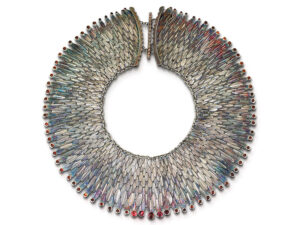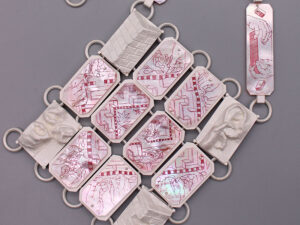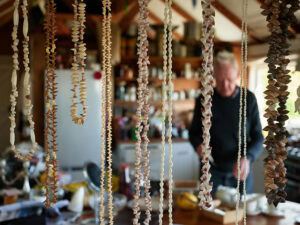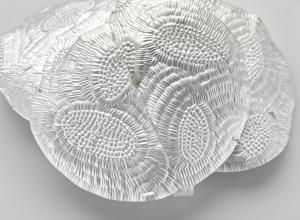
Susan Cummins: Can you give us the story of how you became a jeweler?
Julie Blyfield: My passion for jewelry and metal began in 1976. I was training to be a secondary school art teacher at Torrens College of Advanced Education at Underdale, west of Adelaide, in South Australia. (Now it is the University of South Australia, City West.) Carole-Ann Fooks was my jewelry lecturer. She introduced me to working with metal combined with mixed materials, such as bone, shell, and casting.
For many years, I taught jewelry making in secondary schools while making my own pieces at home in my spare time. I lived in regional South Australia when I first started teaching, so I had plenty of spare time to pursue my interest and passion.
Next, I returned to live in Adelaide and went back to night classes at Adelaide College of the Arts and Education to learn a few more skills, including enameling, chasing, and repoussé. In 1985, I enrolled in an associate diploma in jewelry making and joined Gray Street Workshop, a jewelry collective in Adelaide. I began as an access tenant, and then became a partner in the workshop that lasted 23 years.

Susan Cummins: Can you give us the story of how you became a jeweler?
Julie Blyfield: My passion for jewelry and metal began in 1976. I was training to be a secondary school art teacher at Torrens College of Advanced Education at Underdale, west of Adelaide, in South Australia. (Now it is the University of South Australia, City West.) Carole-Ann Fooks was my jewelry lecturer. She introduced me to working with metal combined with mixed materials, such as bone, shell, and casting.
For many years, I taught jewelry making in secondary schools while making my own pieces at home in my spare time. I lived in regional South Australia when I first started teaching, so I had plenty of spare time to pursue my interest and passion.
Next, I returned to live in Adelaide and went back to night classes at Adelaide College of the Arts and Education to learn a few more skills, including enameling, chasing, and repoussé. In 1985, I enrolled in an associate diploma in jewelry making and joined Gray Street Workshop, a jewelry collective in Adelaide. I began as an access tenant, and then became a partner in the workshop that lasted 23 years.
Frank Bauer taught me the technique of raising metal in 2003. Frank was very generous in sharing his skills and knowledge in his beautiful home studio near Adelaide. The Department of the Arts in South Australia generously financed this mentorship with Frank.
Finally, in 2010, I set up my own home studio overlooking my back garden, which is my haven!
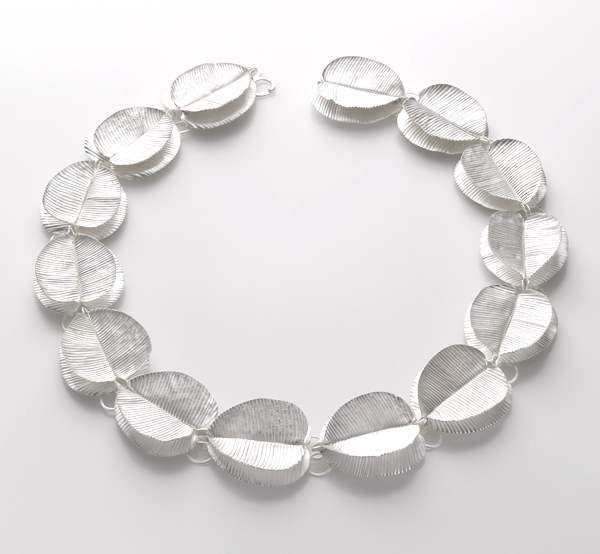
Julie Blyfield: While looking into my family history, I discovered that generations of my ancestors were interested in gardens and gardening. My great grandfather worked for Sutton and Sons Seeds Company in England, and he travelled the world with his work. I learned that my grandmother was a passionate gardener, as was my father, so I guess it was in my genes. For recreation, I follow my interest and love of our garden, and this has inspired my jewelry and metalwork.
Some of your work looks like shells or sea creatures rather than plant forms. Are these some special Australian plant specimens?
Julie Blyfield: Every Christmas, my partner and I spend time with friends on the remote southeast coast of Kangaroo Island. The coastal scrub is dense, and the beach is littered with plants from the sea. I typically collect, observe, and document the specimens seen and experienced on our daily walks. It is not my intention to replicate plant forms in a botanically correct fashion, but I try to capture the essence of the things I discover.
Which specific botanical specimens are your favorites to work with?
Julie Blyfield: I really enjoy working with all plant forms but particularly the Australian eucalypts, wattles, and other native plants. Quite often, my eye is attracted to the simple leaf and petal forms I collect on walks in my neighborhood or places we visit in the remote desert of northeast South Australia. The diverse range of native grasses and exotic plants, including a quandong tree, succulents, and gardenias in our garden, inspire me.
Would you talk about the title of your show Second Nature?
Julie Blyfield: In 2012, I decided I wanted my work to gradually evolve and change over time in response to new discoveries. I restricted the scale, materials, techniques, and time allocated for designing and making pieces. Over the year, one piece evolved into another. Second Nature was an apt title as I was literally working with an ephemeral natural resource and translating it into something fixed and tangible. It also describes the physical act of repeating a process or technique that I have practiced for many years until it has become automatic — the eye, hands, and brain are connected.
Is silver your preferred material? Why?
Julie Blyfield: I really enjoy working with silver because it is malleable and has the ability to distort, twist, and curl as it work hardens. I use the technique of chasing and small steel tools to texture the annealed and softened silver surface, which gradually hardens causing the tension in the metal. I enjoy the way the silver moves in unpredictable ways at times. This challenges the way I resolve making a brooch or a neckpiece. Silver has the qualities of strength and delicacy at the same time.
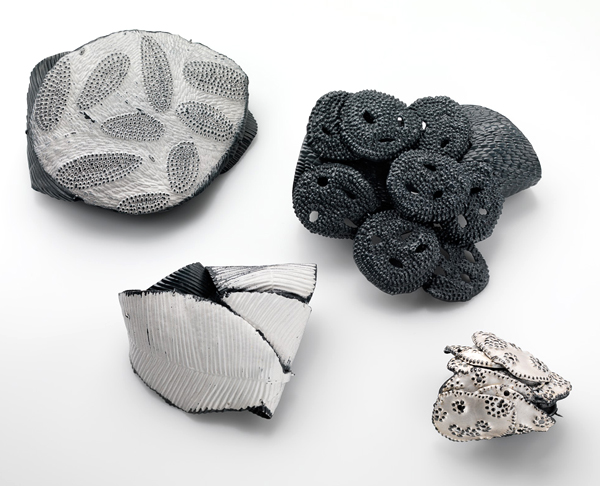
Julie Blyfield: Both come from the earth, but one is hard and cold and the other is ephemeral, soft, and pliable. It is interesting to translate one to the other. To make the silver appear soft, delicate, and pliable is the challenge.
I understand that you live in Adelaide, South Australia. I think JamFactory is there, right? Can you tell us something about the town and about JamFactory?
Julie Blyfield: Adelaide is the capital city in a state of just over one million people. It is the land of the Kaurna people, the original Aboriginal inhabitants of this area. Adelaide is a great city that supports a vibrant craft and design community. The River Torrens flows through the city center, the Adelaide Hills are a 20-minute drive to the east, and the coastal beach is about the same distance to the west.
Now in its fortieth year, JamFactory is a major crafts and design center located in the west end of the city. It contains two galleries, two retail spaces, and has training workshops in the areas of glass, metal, furniture, and ceramics. JamFactory is a focal point for the crafts and design in Adelaide and South Australia. It brings practitioners from all over Australia and beyond to work and live in our city. Most people who come to Adelaide for a two-year training program in one of the JamFactory studios end up staying because the city is affordable and has a supportive arts community.
Every year for two weeks in August, the SALA (South Australian Living Artists) Festival celebrates the artists living in the city and country areas of our state by hosting an extensive and diverse range of exhibitions and art events. The festival began 16 years ago and is still widely supported and growing!
Each year as part of he SALA festival, one South Australian artist is awarded a monograph publication celebrating her life and work. A South Australian writer is paired with the selected artist for this publication, which is funded and produced by Wakefield Press and Arts SA. In 2007, I was fortunate to be selected as the SALA recipient.

What is your current favorite book on jewelry?
Julie Blyfield: My friend recently gave me a small book called Khmer Silversmiths by Kong Vireak. I am enjoying reading it and looking at the incredible craftsmanship and processes that have been documented.
I also love my David Huycke book, which elegantly shows his rich and amazing metal work. It would be great to own one of those pieces! Another favorite is Mind Flights by Lucy Sarneel. There are many more, of course!
Thank you.

